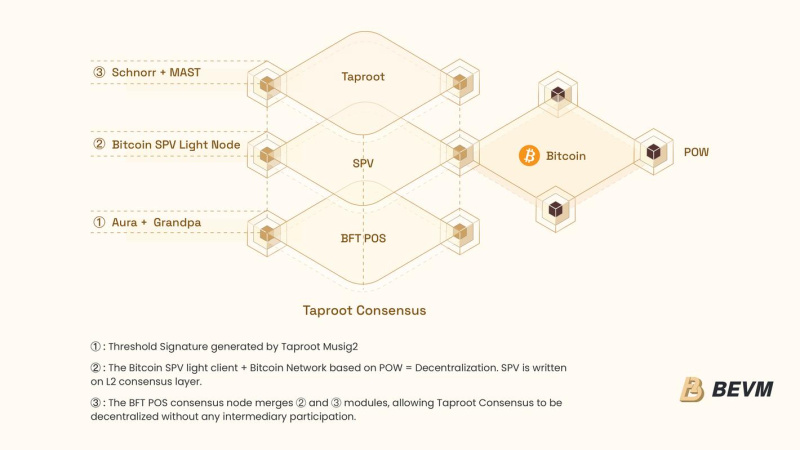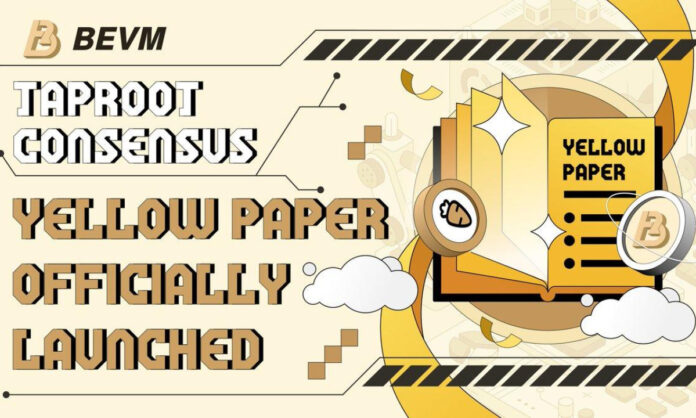Cardiff, UK, 26 Might 2024, Chainwire
On Might 20, 2024, the Bitcoin Layer2 BEVM improvement staff launched a technical yellow paper titled “Taproot Consensus: A Decentralized BTC Layer2 Resolution”. This paper particulars the implementation of Taproot Consensus, utilizing native Bitcoin applied sciences akin to Schnorr signatures, MAST and Bitcoin SPV nodes, to construct a totally decentralized BTC Layer2 answer. Taproot Consensus represents a big leap in native bitcoin scalability, innovatively combining current bitcoin applied sciences with out modifying the underlying bitcoin code.
I. Historical past of Bitcoin's Technical Iterations
- 31 October 2008: Satoshi Nakamoto revealed “Bitcoin: Peer-to-Peer Digital Money System” by which he launched Bitcoin and the idea of SPV (Easy Cost Verification).
- January 3, 2009: Nakamoto mined the Genesis Block and launched Bitcoin. The unique code used ECDSA for digital signatures as an alternative of the extra appropriate Schnorr signatures, which had been below patent safety on the time. Schnorr signatures retain all of the options and safety assumptions of ECDSA and may overcome ECDSA's restrict of 15 signatures, permitting bitcoin administration with 1000’s of addresses with out affecting signing pace.
- 2018: Bitcoin core builders proposed integrating Schnorr signatures into the Bitcoin community.
- November 14, 2021: The Taproot improve built-in Schnorr signatures and launched MAST (Merkelized Summary Syntax Timber), enabling sensible contract-like options and decentralized administration of a number of signatures.
- BEVM's Taproot Consensus answer builds on these enhancements and combines Schnorr and MAST signatures for multi-signature handle administration and permits complicated enterprise situations on the Bitcoin layer2.
II. Taproot Consensus Resolution Overview:
The yellow paper begins by highlighting the non-Turing full nature of Bitcoin and the restricted performance for sensible contracts. It argues for utilizing Bitcoin's current capabilities to construct a decentralized Layer2 answer fairly than modifying Bitcoin's Layer 1.
BEVM's Taproot Consensus combines Bitcoin's Taproot know-how (Schnorr signatures and MAST), Bitcoin SPV light-weight nodes, and the BFT PoS consensus mechanism to create a decentralized and constant Layer2 community.
III. An in depth clarification of the Taproot Consensus Structure

The Taproot Consensus structure consists of three primary elements: Schnorr+MAST, Bitcoin SPV and Aura+Grandpa.
· Schnorr+Ointment: It makes use of these applied sciences from the Taproot improve to realize decentralized Bitcoin administration with a number of signatures managed by the Bitcoin code.
· Bitcoin SPV: It permits the synchronization and verification of Bitcoin transactions with out working a full node.
· Aura + Grandpa: Superior PoS consensus protocols for Byzantine fault tolerance guaranteeing excessive consistency between community nodes.
Within the BEVM system, every validator has a personal BTC key for Schnorr signatures. The aggregated public key types a MAST tree, enabling BTC transfers and writes to the brink signature handle. Validators act as light-weight Bitcoin SPV nodes that securely and permissionlessly synchronize the state of the BTC community. Aura+Grandpa ensures the safety and belief of the Layer2 community with BFT consensus managed belongings.
The working precept of Taproot Consensus is: “Within the BEVM system, every validator has a personal BTC key for Schnorr signatures. The traits of Schnorr signatures enable environment friendly aggregation of signatures, thereby growing the safety and effectivity of the system. The aggregated Pagg public key, generated by means of the Musig2 multi-signature scheme, types a big MAST (Merkle Summary Syntax Tree). After producing the foundation hash of the MAST tree, the validators carry out BTC transfers and writes to the brink signature handle generated by the MAST tree, permitting information to be despatched from the BTC mainnet to the BEVM community. Every validator additionally acts as a light-weight Bitcoin SPV (Simplified Cost Verification) node, permitting them to sync the state of the BTC community securely and with out permission.”
IV. Extra technical particulars within the Yellow Guide – True Decentralization
The yellow paper additionally particulars the implementation of Schnorr signatures, MAST, Bitcoin SPV and Aura+Grandpa mild nodes, offering a complete technical overview for these occupied with Bitcoin applied sciences. It explains the implementation of Musig2 and contrasts it with different BTC Layer2 tasks akin to Mezo, which makes use of the tBTC protocol. In contrast to tBTC, which depends on a community of 9 signatories, Taproot Consensus integrates multi-signature networks with BFT PoS consensus, attaining true decentralization.
As well as, the yellow e-book explains the implementation strategy of Musig2 and the variations between different BTC Layer2 tasks akin to Mezo and Taproot Consensus. The fundamental technical construction of Mezo is predicated on the tBTC protocol, which makes use of Bitcoin multi-signatures to create a threshold signature community that gives sturdy consistency in comparison with conventional distributed networks. Nonetheless, tBTC nonetheless depends on a community of 9 signatories, whereas a really decentralized system needs to be consensus-based and mix multi-signature networks with BFT PoS (Byzantine Fault Tolerance Proof of Stake) consensus mechanisms. That is the distinction between distributed networks and blockchains; distributed networks emphasize distribution however lack fault-tolerant Byzantine consensus, whereas blockchains, though additionally distributed networks, are ruled by fault-tolerant Byzantine consensus, attaining true decentralization. The Taproot Consensus answer adopts this extra superior design. By integrating Schnorr signatures, MAST, light-weight Bitcoin SPV nodes, and fault-tolerant Aura and Grandpa Byzantine consensus mechanisms, it creates a extremely constant and safe decentralized Layer2 scalability answer. This integration will increase the scalability and usefulness of the Bitcoin community and ensures the safety and consistency of the BEVM community.
Conclusion
The BEVM staff's technical yellow paper comprehensively describes Taproot Consensus, a Bitcoin Layer2 answer constructed completely on native Bitcoin applied sciences. It respects and innovates on Bitcoin's authentic know-how course, making it a real evolution of Bitcoin's native scalability know-how. Because the Bitcoin ecosystem evolves, options like Taproot Consensus will probably be key to its improvement and can function the primary constructing blocks for really decentralized Bitcoin Layer2 options.
About BEVM
BEVM is the primary totally decentralized Bitcoin Layer 2 answer suitable with EVM. It permits DApps of the Ethereum ecosystem to run Bitcoin and use BTC as gasoline. BEVM enhances the utility of Bitcoin by offering a safe and scalable platform for decentralized functions. The system integrates superior consensus mechanisms, cross-chain interactions and strong information integrity to make sure seamless operation. BEVM goals to innovate inside the Bitcoin ecosystem by providing elevated scalability, safety and compatibility with in style Ethereum instruments and functions.
For extra info, customers can go to BEVm's official web site or comply with BEVM on Twitter.
Contact
Tommy
BEVM
(electronic mail protected)
